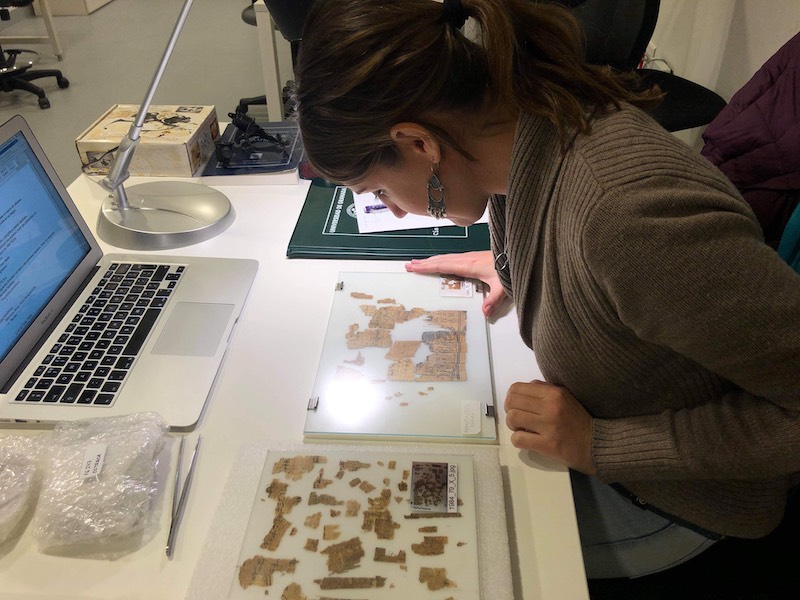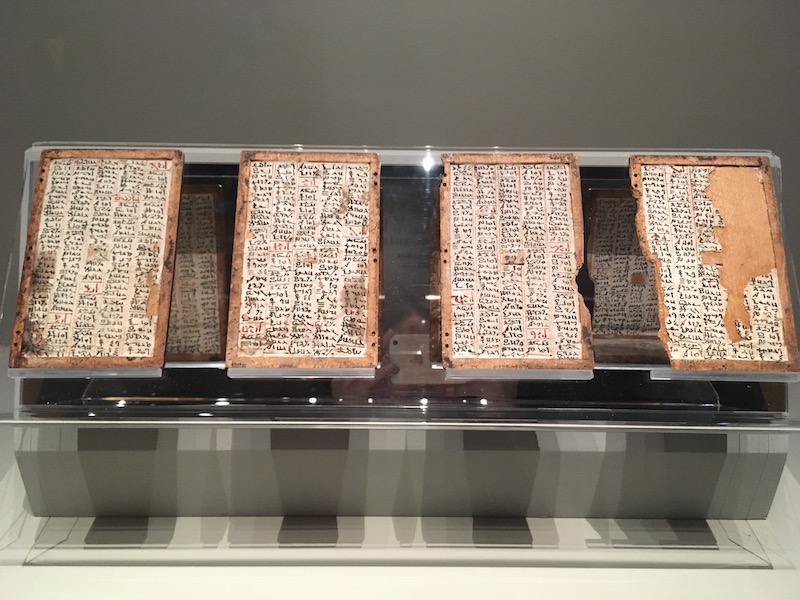Demotic: Opening New Windows into the Understanding of Egyptian History and Culture
The term “Demotic” refers to a stage of the ancient Egyptian language, as well as the script in which this stage of the language was generally, though not exclusively, written. The language seems to have been close to that spoken in the 26th dynasty, which developed from the Late Egyptian language of the New Kingdom. Demotic precedes Coptic, in which the Egyptian language was written for the first time in a non-Egyptian script derived from the Greek alphabet.
The first documents in demotic script date to around 650 BCE, with the last dated Demotic text located in the temple of Philae and inscribed in 452 CE. This script had a lifespan of over a millennium, within which it evolved and changed. Scholars have divided this development into three main stages: early demotic, which corresponds to texts written in the Late Period (7th to 4th centuries BCE); middle demotic, corresponding to the Ptolemaic Period (end of the 4th century century to end of the 1st century BCE); and the final stage of late demotic or Roman demotic (from the end of the 1st century BCE to the 5th century CE).
The Demotic script is a very cursive development from hieratic, a stylized version of the hieroglyphic script used since the 3rd millennium BCE to allow faster writing, mostly with brush and ink on papyrus and ostraca. Demotic appears to have started in the Delta region, where the royal family of the 26th dynasty originated. Under the Saite administration, it became the standard for documents countrywide, relegating hieratic script for the most part to non-documentary texts. The designation “demotic” is first found in Herodotus, who called it δημοτικὰ γράμματα “the script of the people,” or the script used in daily activities instead of the sacred hieroglyphic script used in monuments. In Egyptian it was designated as “letter writing,” which highlights its use as an administrative script. Like hieratic, demotic script was written from right to left. But unlike hieratic signs, in which hieroglyphs are identified, demotic developed as an abbreviated form involving an abundance of ligatures – new shapes formed by a combination of previous signs.
In the Late Period, Demotic was limited to administrative, economic and legal documents, but it began to be used in the Graeco-Roman period for literature, religious treatises, science and other documents. This means the study of Demotic texts provides a wealth of information on later Egyptian history, illuminating areas with previously limited understanding. The study of Demotic texts has notably increased knowledge and perspectives in Egyptology, as these three examples demonstrate:
1) Analysis of the second book of Herodotus’ Histories: Egyptologists have long debated the veracity of the narratives and descriptions from Herodotus, even dismissing some as inventions of Herodotus’ Egyptian interlocutors. However, continuing study of Demotic literary sources is providing interesting parallels between Herodotus’ narratives and indigenous traditions. Herodotus indicates in many occasions that his sources for these narratives had been Egyptian priests. A significant amount of Demotic literary papyri have been found as part of the libraries of temples, most notably the Tebtunis Temple Library in the Faiyum. Although this library and most manuscripts date to the Roman period, the temple’s narratives probably arose from earlier libraries, being considered as authoritative traditions within the priestly milieu of the Late Period, when Herodotus visited Egypt. At the start of the Ptolemaic Period, Manetho likely incorporated the same sources in his Aigyptiaka. While Manetho’s Egyptian history has been transmitted only in abbreviated form by later scholars, the survival of several narratives indicates Manetho’s writing originally may have contained short descriptions of each ruler that had been preserved in Egypt’s temple archives.
2) The Alexander Romance, a narrative of the life of Alexander the Great that combines facts with fictional elaborations: The first book of the romance relates the conception, birth and childhood of Alexander. The narrative starts in Egypt, during the reign of the last indigenous king, Nectanebo II, who is portrayed as a magician. He foresees his defeat by an invading Persian army and flees to Pella, the capital of Macedon. Nectanebo then takes the form of the Egyptian god Amun to seduce queen Olympias. She becomes pregnant and gives birth to Alexander, whose real father would then be Nectanebo.
Although the Alexander Romance has a very complicated manuscript tradition, it is thought to have originally been composed around the end of the third century BCE. The abundance of Egyptian elements in the first book made scholars long suspect that the section came from native Egyptian traditions about Nectanebo. A Greek text from the Serapeum of Saqqara known to us as Nectanebo’s Dream has been recognized as belonging to the same narrative tradition as the beginning of the Alexander Romance, perhaps translated from an original Demotic text. Finally, four Demotic papyrus fragments from the Carlsberg collection have provided a parallel to the beginning
of Nectanebo’s Dream and a sequel, confirming its Egyptian origin and raising the possibility of eventually finding an Egyptian parallel to parts of the Alexander Romance. These documents help explain the interactions between Greek and Egyptian narrative traditions, as well as Alexander’s legitimacy narrative within Egypt itself.
3) Demotic contributions to knowledge of ancient science and its cultural and social context: The predominant scholarly view during the 20th century was that Egypt had no relevant role in the transmission of astronomical knowledge from the Near East to the Graeco-Roman world. Within Egypt, chances of preservation and especially publication preferences among scholars had resulted in the existence in our available textual corpus of a majority of astronomical sources written in Greek, and of astrological manuals in Demotic. This led to the conclusion that Greek astronomy was more “scientific,” while Egyptians were more superstitious. Scholars also thought Egyptian astronomical tables were less complex than those in Greek. Recently, increased study of Demotic scientific sources has documented new astronomical tables comparable in complexity and format to those in Greek. These discoveries allow for a reinterpretation of the historical context of all these documents. Language can no longer be used as a mark of cultural origin, since both Greek and Demotic tables may have been written in the same milieu and by the same people. The use of symbols of Egyptian origin in the Greek tables also points to the decisive role of Egypt as the place in which the Greeks entered in contact with the Near Eastern astronomical traditions.
Recommended Reading:
The Chicago Demotic Dictionary
Depauw, Mark. A Companion to Demotic Studies. Bruxelles: Fondation Égyptologique Reine Élisabeth, 1997.
Erichsen, Wolja. Demotisches Glossar. Copenhagen: Ejnar Munksgaard, 1954.
Hoffmann, Friedhelm and J. F. Quack, Anthologie der demotischen Literatur. Berlin: LIT Verlag, 2007.
Johnson, Janet H. Thus Wrote ‘Onchsheshonqy: An Introductory Grammar of Demotic. Chicago: Oriental Institute of the University of Chicago, 2000.
Quack, Joachim. Einführung in die altägyptische Literaturgeschichte III. Die demotische und gräko-ägyptische Literatur. 2nd ed. Berlin: LIT Verlag, 2009.
Quack, Joachim. “Quelques apports récents des études démotiques à la comprehension du livre II d’Hérodote” In Hérodote et l’Égypte. Regards croisés sur le Livre II de l’Enquête d’Hérodote, edited by L. Coulon, P. Giovanelli-Jouanna and Flore Kimmel-Clauzet. Lyon: Maison de l’Orient et de la Méditerranée, 2013. pp. 63–88.
Quack, Joachim. “On the Concomitancy of the Seemingly Incommensurable, or Why Egyptian Astral Tradition Needs to be Analyzed within Its Cultural Context” In The Circulation of Astronomical Knowledge in the Ancient World, edited by J. M. Steele. Leiden: Brill, 2016. pp. 230-244.
Ryholt, K. “Nectanebo’s Dream or the Prophecy of Petesis” In Apokalyptik und Ägypten: eine kritische Analyse der relevanten Texte aus dem griechisch-römischen Ägypten, edited by A. Blasius and B. U. Schipper. Leuven: Peeters, 2007. pp. 221-241.
Spiegelberg, Wilhelm. Demotische Grammatik. Heidelberg: Carl Winters Universitätsbuchhandlung, 1925.

